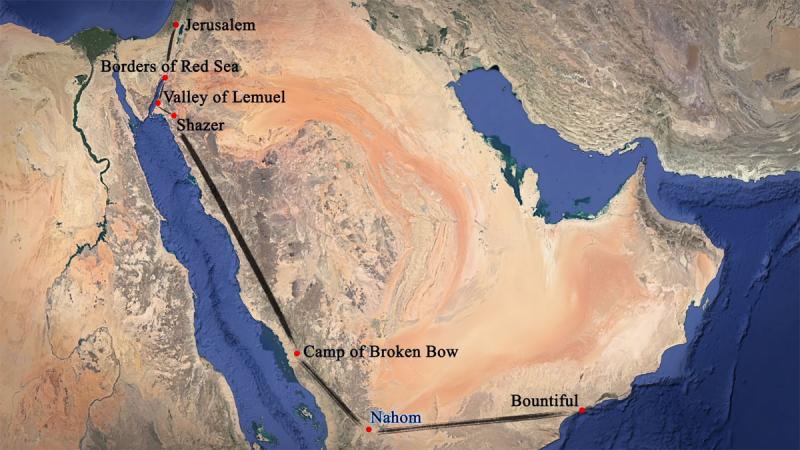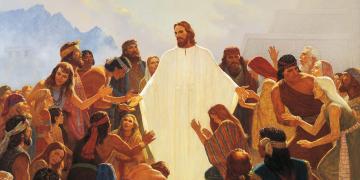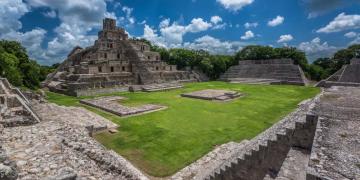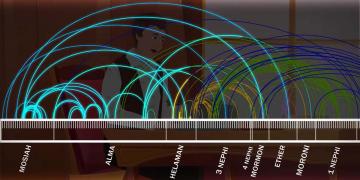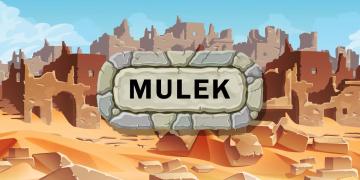You are here
Archaeological Evidence for 7 Locations on Lehi’s Journey to the Promised Land
When Lehi embarked on his journey around 600 B.C., little did he know that millions of people would read and wonder about his story thousands of years later. While there is still much to learn about the people and stories in the Book of Mormon, some of the best archaeological evidence to support the Book of Mormon comes from Lehi’s journey to the promised land.
Seven notable locations are specifically mentioned in 1 Nephi as points along Lehi’s journey: Jerusalem (1 Nephi 1:4), the “borders of the Red Sea” (1 Nephi 2:6), the Valley of Lemuel (1 Nephi 2:8), Shazer (1 Nephi 16:13), the camp of the broken bow (1 Nephi 16:17–18), Nahom (1 Nephi 16:34), and Bountiful (1 Nephi 17:5).
Watch: Compelling Book of Mormon Evidence for Lehi’s Journey through Arabia
1. Jerusalem
Lehi’s story begins in Jerusalem, he having dwelt there “all his days” (1 Nephi 1:4). Jerusalem is perhaps the most archaeologically scrutinized city in the entire world, as it is important to three major world religions and is the epicenter of many events in the Bible. As such, we have a good amount of archaeological information about how people lived in Jerusalem in 600 B.C. To learn all about what Lehi’s Jerusalem was like, you can read Glimpses of Lehi’s Jerusalem, available on the Book of Mormon Central Archive.
There are a few things about the way Nephi describes Jerusalem that match well with what we know about the city in 600 B.C. Nephi describes his writing as “the learning of the Jews and the language of the Egyptians” (1 Nephi 1:2). Interestingly, archaeologists have discovered pottery in Israel that contains Egyptian hieratic in combination with some conventions of the Hebrew language.
When Nephi and his brothers go back and forth to Jerusalem to get the brass plates and the family of Ishmael, they always refer to Jerusalem’s elevation in consistent ways. Whenever they go towards Jerusalem, they “go up,” and whenever they leave Jerusalem into the wilderness, they “go down.” This is consistent with how ancient Israelites perceived Jerusalem geographically, and even theologically. Jerusalem was located in the Judean hill country, elevated above the surrounding regions. Because Jerusalem was also the home of Solomon’s temple, journeys toward the city were seen as a heavenly ascent to a sacred place.
While these are only two pieces of evidence, explore the articles and books below to get a sample of all the archaeological evidence for Jerusalem that coincides with how Lehi and Nephi describe their home city.
Further Reading
John W. Welch, David Rolph Seely, and Jo Ann H. Seely, eds., Glimpses of Lehi’s Jerusalem (Provo, UT: Foundation for Ancient Research and Mormon Studies, 2004).
Book of Mormon Central, “Did Ancient Israelites Write in Egyptian? (1 Nephi 1:2),” KnoWhy 4 (January 5, 2016).
Book of Mormon Central, “Watch: Archaeological evidence for Egyptian writing by Israelites in Book of Mormon times,” BMC Blog (February 9, 2019).
Book of Mormon Central, “Why Does Nephi Always Go Down to the Wilderness and Up to Jerusalem? (1 Nephi 3:4),” KnoWhy 6 (January 7, 2016).
Book of Mormon Central, “Why Does the Book of Mormon Talk about a “Land of Jerusalem”? (1 Nephi 3:9),” KnoWhy 495 (December 20, 2018).
Book of Mormon Central, “Were Any Ancient Israelite Women Named Sariah? (1 Nephi 5:1),” KnoWhy 8 (January 11, 2016).
Book of Mormon Central, “Video: New Archaeological Evidence for Sariah as a Hebrew Woman’s Name,” BMC Blog (April 5, 2019).
2. The Borders of the Red Sea
When Lehi and his family travel south, they describe traveling both “by” the borders of the Red Sea, and “in” the borders of the Red Sea (1 Nephi 2:5). Researchers George Potter and Richard Wellington believe that “borders” may refer to mountains or cliffs adjacent to the Red Sea coast. The Gaza branch of the Frankincense trail reaches the northern tip of the Red Sea, and then proceeds south along the Red Sea coast, which is flanked in by a formidable mountain range. After reaching the proposed location for the Valley of Lemuel, the Frankincense trail then proceeds inland to join with the main vein of the Frankincense trail as it goes south to Yemen. As Lehi and family reached the Red Sea coast, they would have well surpassed the 3-day travelling requirement for Israelites to offer their own sacrifices outside the Jerusalem temple, as Lehi demonstrates in 1 Nephi 2:7.
Further Reading
Richard Wellington, and George Potter, “Lehi’s Trail: From the Valley of Lemuel to Nephi’s Harbor,” Journal of Book of Mormon Studies 15, no. 2 (2006): 26–43, 113–116.
Book of Mormon Central, “How Could Lehi Travel from Jerusalem to the Red Sea in 3 Days?” Q&A Post (January 29, 2018).
Book of Mormon Central, “How Could Lehi Offer Sacrifices Outside of Jerusalem? (1 Nephi 7:22),” KnoWhy 9 (January 12, 2016).
Book of Mormon Central, “What Sacrifices did Lehi Offer to God in the Wilderness? (1 Nephi 7:22),” KnoWhy 545 (January 9, 2020).
Book of Mormon Central, “Did Lehi Use the Poetry of the Ancient Bedouin? (1 Nephi 2:9–10),” KnoWhy 5 (January 6, 2016).
3. The Location of the Valley of Lemuel
In 1 Nephi 2, Lehi and his family settle their camp in a valley with a river, whose mouth opens into the Red Sea. Lehi “called the name of the river, Laman” (1 Nephi 2:8) and called the valley after his son Lemuel. Researchers have remarkably identified a location that matches Lehi’s description of a valley that is “firm and steadfast, and immoveable” (1 Nephi 2:10), and a river that is “continually running” (1 Nephi 2:9).
Wadi Tayyib al-Ism is an impressive valley located today in northwest Saudi Arabia along the Red Sea. It is approximately a 3-days journey away from the northern-most tip of the Red Sea (1 Nephi 2:6), and it has sheer granite walls rising about 2000 ft to form a formidable valley. Most significantly, Wadi Tayyib al-Ism has a small stream (that during flood seasons and in ages past was much more like a river) of water that flows all-year long, even during the dry season—a rare find in the deserts of Arabia.
Further Reading
Book of Mormon Central, “Have the Valley of Lemuel and the River Laman Been Found? (1 Nephi 2:6),” KnoWhy 286 (March 13, 2017).
Book of Mormon Central, “What was the Great and Terrible Gulf in Lehi’s Dream? (1 Nephi 12:18),” KnoWhy 14 (January 19, 2016).
Warren Aston, “What Did the River of Filthy Water and the River of Laman Look Like?” Book of Mormon Central Blog (January 22, 2020).
For an alternative location of the Valley of Lemuel, see:
Jeffrey R. Chadwick, “The Wrong Place for Lehi’s Trail and the Valley of Lemuel,” FARMS Review 17, no. 2 (2005): 197–215.
4. Shazer
Our best clues for the location of Shazer come from its name. The etymology of Shazer has had several proposals. Some have proposed it means “to twist, to intertwine,” possibly a reference to the gnarled and twisted acacia trees that may have populated the area. Hugh Nibley and others have suggested it derives from a common Palestinian place-name “shajer” meaning “trees, forest, woody, wooded.” Matt Bowen has most recently proposed that Shazer may come from a Semitic word meaning “gazelle,” referring to the abundant resources for hunting that Lehi’s family may have encountered.
Regardless of which etymology you follow, it appears that the name for Shazer is related to fertility for either fauna or flora. Nephi describes that the location is approximately a four-day journey south-southeast from the valley of Lemuel. As it turns out, Wadi Agharr (also known as Wadi Sharma), located in the northern Hijaz mountains, is a fertile valley with an oasis over fifteen miles long, and is the appropriate distance away from the proposed Valley of Lemuel.
Further Reading
“Shazer,” Book of Mormon Onomasticon.
Matthew L. Bowen, “Shazer: An Etymological Proposal in Narrative Context,” Interpreter: A Journal of Latter-day Saint Faith and Scholarship 33 (2019): 1–12.
Richard Wellington and George Potter, “Lehi’s Trail: From the Valley of Lemuel to Nephi’s Harbor,” Journal of Book of Mormon Studies 15, no. 2 (2006): 26–43, 113–116.
Jeffrey R. Chadwick, “An Archaeologist’s View,” Journal of Book of Mormon Studies 15, no. 2 (2006): 68–77, 122–124.
5. The Camp of the Broken Bow
The location of the place where Nephi broke his bow (1 Nephi 16:18) is known with the least certainty. The best clue we have comes from 1 Nephi 16 where Nephi states that they “did go forth again in the wilderness, following the same direction, keeping in the most fertile parts of the wilderness, which were in the borders near the Red Sea” (1 Nephi 16:14, emphasis added). After they hunted for food, they continued their journey southward in “the more fertile parts of the wilderness” (1 Nephi 16:16, emphasis added).
It appears that as the family traveled southward, the fertility of the land and the family’s opportunities for food grew scarcer. That is indeed what we find along the Frankincense trail, with cultivated land being as far as 50 miles apart from each other in this part of modern-day Arabia. Interestingly, it is in this region near the halt of Bishah that a particular type of olive tree grows that is suitable for crafting a bow. When Nephi broke his steel bow, he likely would have used the wood from the Attim or wild olive tree to craft his wooden bow (1 Nephi 16:23).
Further Reading
Richard Wellington and George Potter, “Lehi’s Trail: From the Valley of Lemuel to Nephi’s Harbor,” Journal of Book of Mormon Studies 15, no. 2 (2006): 26–43, 113–116.
Book of Mormon Central, “Why Did Nephi Include the Story of the Broken Bow? (1 Nephi 16:23),” KnoWhy 421 (April 3, 2018).
6. Nahom
Unlike all the other places Lehi stopped, it appears he did not give this place a name. Instead, Nahom was likely already given as a name for this location by the residing population (1 Nephi 16:34). If the place was called Nahom back in Lehi’s time, you might expect to be able to find it in the archaeological record, and that’s exactly what we find in southern Arabia, along Lehi’s trail. Researchers found the name “Nehem” on a 1763 map of Arabia, and then in 1997, German archaeologists discovered an altar that dated back to Lehi’s time, with an inscription containing the name “NHM.”
The location of the Nehem tribal area in southwestern Arabia also corresponds well with Lehi’s position along his journey. Nephi recounts that after leaving Nahom they “did travel nearly eastward from that time forth” (1 Nephi 17:1) until they reached Bountiful, which is likely located along the coast of Oman.
Further Reading
Book of Mormon Central, “Who Called Ishmael's Burial Place Nahom? (1 Nephi 16:34),” KnoWhy 19 (January 26, 2016).
Book of Mormon Central, “Evidences of the Book of Mormon: Nahom,” BMC Blog (June 17, 2017).
Warren P. Aston, “Newly Found Altars from Nahom,” Journal of Book of Mormon Studies 10, no. 2 (2001): 56–61, 71.
Neal Rappleye and Stephen O. Smoot, “Book of Mormon Minimalists and the NHM Inscriptions: A Response to Dan Vogel,” Interpreter: A Journal of Latter-day Saint Faith and Scholarship 8 (2014): 157–185.
7. Bountiful
After traveling due eastward, Lehi’s family eventually reaches the coast of the Arabian Peninsula in modern-day Oman. Researcher Warren Aston has identified Khor Kharfot, an inlet in the Dhofar region, as a potential location for Bountiful. He also identified twelve requirements that must be present in the vegetation and landscape to qualify, as described in 1 Nephi 17–18. Khor Kharfot matches well Nephi’s description of having fresh water, fruit, honey, access to the coast, mountains and cliffs, ore for tools, and timber for shipbuilding. George Potter and Richard Wellington have alternatively identified Khor Rori as an ideal fit for the location of Bountiful.
Further Reading
Book of Mormon Central, “Has the Location of Nephi’s Bountiful Been Discovered? (1 Nephi 17:5),” KnoWhy 259 (January 9, 2017).
Richard Wellington and George Potter, “Lehi’s Trail: From the Valley of Lemuel to Nephi’s Harbor,” Journal of Book of Mormon Studies 15, no. 2 (2006): 26–43.
George Potter and Richard Wellington, Lehi in the Wilderness: 81 New, Documented Evidences that the Book of Mormon is a True History (Springville, UT: Cedar Fort, 2003), 121–162.
Warren P. Aston, “The Arabian Bountiful Discovered? Evidence for Nephi’s Bountiful,” Journal of Book of Mormon Studies 7, no. 1 (1998): 4–11, 70.
John W. Welch, and J. Gregory Welch, “Twelve Requirements for the Land of Bountiful,” in Charting the Book of Mormon: Visual Aids for Personal Study and Teaching (Provo, UT: Foundation for Ancient Research and Mormon Studies, 1999), chart 148.
Book of Mormon Central, “Why Would Nephi Call the Ocean ‘Irreantum’? (1 Nephi 17:5),” KnoWhy 20 (January 27, 2016).
Book of Mormon Central, “Did Ancient People Sail the Seas? (1 Nephi 18:8),” KnoWhy 21 (January 28, 2016).
Conclusion
Evidence that supports the narratives in the Book of Mormon is ever increasing. While we still have much to learn about the ancient world and how it correlates with the Book of Mormon, the stories in 1 Nephi fit right at home in 7th century Israel. The locations of Lehi’s journey are beginning to be identified, and details about his experiences in the wilderness correlate well with what we know about the ancient Near East. Elder Jeffrey R. Holland has encouraged members of The Church of Jesus Christ of Latter-day Saints to embrace and seek after evidences of the gospel of Jesus Christ:
In making our case for the restored gospel of Jesus Christ, I believe God intends us to find and use the evidence He has given—reasons, if you will—which affirm the truthfulness of His work…Thus armed with so much evidence of the kind we have celebrated here tonight, we ought to be more assertive than we sometimes are in defending our testimony of truth.
As members of the Church take to heart the commission to be more assertive in defending our testimonies by studying and researching evidences, the Book of Mormon will surely get better with age.
Jeffrey R. Holland, “The Greatness of the Evidence,” Chiasmus Jubilee August 17, 2017.
Watch the video below for a summary of all the evidences for Lehi’s journey to the Promised Land.
Subscribe
Get the latest updates on Book of Mormon topics and research for free


